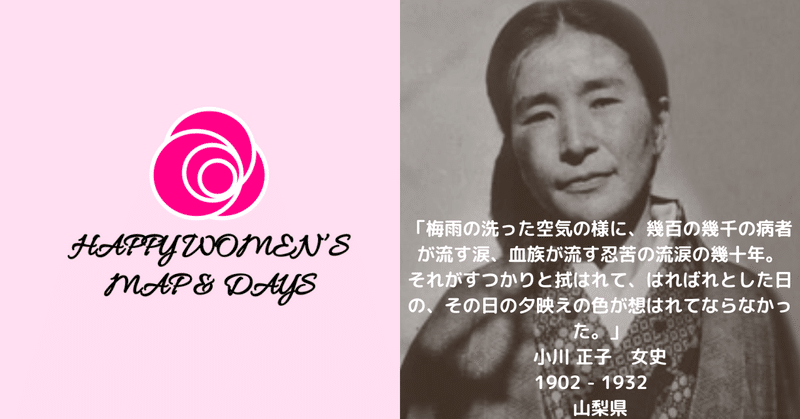
Happy Women's Map 山梨県 貞明皇后の「恩愛」の「代行者」 小川 正子 女史

小川 正子 女史
Ms. Masako Ogawa
1902 - 1932
山梨県東山梨郡笛吹市春日居村 生誕
Born in higahiyamanshi-city, Yamanashi-ken
「梅雨の洗った空気の様に、幾百の幾千の病者が流す涙、血族が流す忍苦の流涙の幾十年。それがすつかりと拭はれて、はればれとした日の、その日の夕映えの色が想はれてならなかった。」
"Like the air washed by the rainy season, the tears of hundreds, thousands of patients, the tears of blood relatives enduring pain for decades. All of that was completely wiped away, and the vivid colors of the evening sun on that day, on that day, were remembered."
小川正子女史は戦時下に国家事業である救癩事業の現場で活躍、女性として慈愛に満ちた手記『小島の春』を発表します。文部省の推薦図書に選ばれ、貞明皇后の「恩愛」の「代行者」とされ、長きにわたりブームならびに論争また闘争を巻き起こします。
Ms. Masako Ogawa played an active role on the frontlines of the state project during wartime, the leprosy relief program. As a woman, she published the compassionate memoir "Spring at Kojima." This work was selected as a recommended book by the Ministry of Education, positioned as a "proxy" for Empress Teimei's "benevolence and affection," sparking long-lasting trends as well as debates and struggles.
*******
正子は山梨県東山梨郡春日居村(現在の笛吹市)で製糸業を営む素封家の四女として生まれます。甲府高等女学校を卒業後、19歳で遠縁にあたる樋貝詮三(後の第3次吉田内閣の国務大臣・賠償庁長官)と結婚するもすぐに離婚します。22歳で東京女子医学専門学校に入学。病院見学で訪れた東京都東村市のハンセン病療養所の多摩全生病院で、ハンセン病研究の第一人者である光田健輔と出会い、ハンセン病患者救済を決意します。卒業後、光田健輔を訪問するも開業できる腕になるまで修行するよう促され、東京市立大久保病院などで内科と細菌学の臨床研究に従事します。まもなく国立ハンセン病療養所として瀬戸内長島に長島愛生園が設立され光田が初代園長に就任、30歳の正子は手荷物一つで押しかけ翌日から医務嘱託として勤務します。当時、医療最先端の現場は男性に独占される一方、救癩事業の現場では女性の慈愛に満ちた活躍を大いに求めらます。正子は地元の役人また巡査と一緒に精力的に瀬戸内の島々また四国の山あいの村々を巡ってハンセン病患者を収容、残された家族はじめ住民を啓蒙、検診の記録を残し続けます。36歳で結核を発病すると、島で闘病生活を送りながら、『小島の春 ある女医の手記』をまとめ上げます。園で診療のかたわら短歌を指導する医師・内田守の尽力により、長崎書店より出版されると著名人から文部省の推薦図書に選定され、翌々年には映画化されます。正子は印税をすべてハンセン病患者のために寄贈。40歳で郷里で療養に専念するも翌年死去します。
日本は光田健輔の先導で世界に先駆けてハンセン病患者を「絶対隔離」、患者は強制的に収容され強制労働を課せられ死ぬまで外に出られず、男性は輸精管を切断して生殖能力を奪われ(断種)、女性は強制的に中絶・堕胎されます。正子の小説は「無癩県運動」のプロパガンダだとして活発され、ハンセン病は恐ろしい病気として今直消えない偏見・差別を増幅、 残された家族は社会の偏見・差別から婚家から離縁され、就職先からは解雇され、世間の白眼視に耐えかねて夜逃げ・一家心中も頻繁に起きるようになります。皮膚科医師で文学者でもある太田正雄(木下杢太郎)は「らい病根絶の最上策は隔離ではなく化学的治療である。決して不可能ではない。『小島の春』を感傷時代の最後の記念作品として、感傷主義を終わりにしなければいけない。」と勇気ある発言をしています。1943年にアメリカで開発された治療薬プロミンが戦後から国内でも使用され始めると、患者たちはプロミンをすべての療養所の入所者が使えるように予算化を求め療養所の自治会の全国組織をつくります。日本は国際学会またWHOから解放治療・外来治療を何度も勧告され、1907年からハンセン病患者の絶対隔離を強制していた「らい予防法」は1996年にようやく廃止。正子の『小島の春』は、ハンセン病患者発の文学、明石海人『白描』、北條民雄『いのちの初夜』、藤本とし『地面の底がぬけたんです』、 塔和子『塔和子全詩集』、村越化石『村越化石自選八十句』、 中山秋夫『一代樹の四季』などと一緒に、偏見と闘争の遺産と記憶として語り継がれています。
Born as the fourth daughter of a silk family in Kasuga-kyo Village (now part of Fuefuki City) in Higashiyamanashi District, Yamanashi Prefecture, Masako Ogawa graduated from Kofu Girls' High School. At 19, she married a distant relative, Kenzo Hibai (who later became a Minister of State and the Director-General of the Reparations Agency in the third Yoshida Cabinet), but soon divorced. At 22, she entered Tokyo Women's Medical University. During a hospital visit, she encountered Kensuke Mitsuda, a leading researcher in leprosy, at Tama Zensei Hospital in Higashimura City, Tokyo. This meeting inspired her to commit to aiding leprosy patients. After graduating, she visited Kenso Mitsuda, who urged her to undergo further training before starting her own practice. She engaged in clinical research in internal medicine and bacteriology at Tokyo Metropolitan Okubo Hospital and other institutions. Soon after, the National Leprosy Sanatorium, Naganoshima Aiseien, was established on Setouchi Nagashima, with Kenso Mitsuda becoming its first director. At the age of 30, Masako Ogawa arrived with a single bag and began working as a medical practitioner there. At the time, cutting-edge medical fields were largely dominated by men, yet the leprosy relief field was actively seeking women's compassionate contributions. Masako, along with local officials and policemen, actively traveled across Setouchi's islands and mountainous villages in Shikoku, accommodating leprosy patients, enlightening their families and local residents, and recording examination results. At 36, she developed tuberculosis and continued fighting the disease while compiling "Kojima no Haru: Aru Joshi no Shuki" ("Spring at Kojima: A Female Doctor's Notes"). Thanks to the efforts of Dr. Mamoru Uchida, a physician who also taught tanka poetry lessons at the sanatorium, the book was published by Nagasaki Shoten, chosen as a recommended book by the Ministry of Education, and subsequently made into a film two years later. All of Masako's royalties were donated to leprosy patients. At 40, she focused on recuperation in her hometown but passed away the following year.
Under the leadership of Kensuke Mitsuda, Japan pioneered the policy of "absolute isolation" for leprosy patients, confining them forcefully and subjecting them to forced labor. They were not allowed to leave until they died, with men undergoing vasectomy to eliminate their reproductive capacity and women undergoing forced abortions. Masako's novel was deemed propaganda for the "Leprosy-Free Prefecture Movement," amplifying the ongoing prejudice and discrimination against leprosy patients as a dreadful illness. Families left behind were often abandoned due to societal prejudice and discrimination, leading to divorce and job loss, and they frequently resorted to elopement or joint suicide due to public contempt. Dermatologist and literary figure Masao Ota (Mokutaro Kinoshita) asserted that "the most effective measure against leprosy eradication is not isolation, but chemical treatment. It's by no means impossible. 'Kojima no Haru' must be viewed as a concluding work of sentimentality, ending the era of sentimentalism." When the therapeutic drug Promin, developed in the United States in 1943, started being used in Japan after the war, patients began advocating for budget allocation to ensure access for all patients in sanatoria. They formed a nationwide organization within the sanatorium's self-governing association. Japan received multiple recommendations from international conferences and the WHO for outpatient and liberation treatments, and the "Leprosy Prevention Law" that had enforced the absolute isolation of leprosy patients since 1907 was finally abolished in 1996. Masako Ogawa's "Kojima no Haru" is among works such as "Hakuga" by Akira Akashi, "Inochi no Hatsuya" by Tamio Hojo, "Jimmen no Hoka ga Nuketan Desu" by Toshi Fujimoto, "Towako Zenshishu" by Towako, "Murakoshi Kaseki Zensen Hachijukku" by Kaseki Murakoshi, and "Ichidaiki no Shiki" by Shu'o Nakayama. These works are carried forward as legacies of prejudice and struggle, preserving memories of the past.
-小川正子記念館 Masako Ogawa Memorial Museum
-国立療養所「長島愛生園」歴史館 The National Sanatorium Nagashima Aisei-en

Share Your Love and Happy Women's Story!
あなたを元気にする女性の逸話をお寄せください!
Share your story of a woman that inspires you!
この記事が気に入ったらサポートをしてみませんか?
